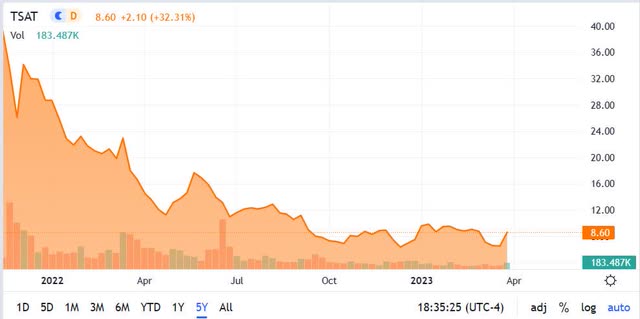humonia
Telesat (NASDAQ:TSAT) is a thinly traded, Canadian-based satellite operator that has traded relatively flat for some time since it began its long decline from approximately $35.00 per share on December 13, 2021, to its 52-week low of $6.00 per share on December 19, 2022.
Since September 14, 2022, it has traded in a range of $6.00 per share to about $10.00 per share, and appears to have found a floor at $6.00, having tested it several times in March 2023 without breaking below it.
After its most recent earnings release, TSAT stock took off, jumping from about $6.40 on March 28, 2023, to $8.27 on March 31, 2023, as I write. I was somewhat surprised because, even though the numbers improved from the prior year, with most metrics lower than the previous year-over-year numbers and guidance pointing to the company reversing direction in 2023, meaning its performance will be weaker than it was in 2021 and 2022 if guidance holds.
With important renewals being lower than what they were before, its contract with DARPA being more of an audition than anything else, and a lot of uncertainty with its Lightspeed projects makes 2023 likely to be a challenging year for TSAT.
In this article we’ll look at some of its earnings numbers, outlook for 2023, and how the prospects for the company look longer term.
Some of the numbers
Revenue in the fourth quarter of 2022 was C$207.00 million, compared to revenue of C$188.00 million in the fourth quarter of 2021. Revenue for full year 2022 was C$759 million, compared to revenue of C$744.00 million in full year 2021, after adjustments for foreign exchange rates; lower by 2 percent year-over-year.
The decline in revenue was attributed to a lower renewal rate from a North American DTH customer, and to a smaller degree, the loss of revenue from short-term services to a satellite operator in 2021 that didn’t repeat itself in 2022.
Adjusted EBITDA in the reporting period was C$139.00 million, compared to adjusted EBITDA of C$133.00 million in the fourth quarter of 2021, down 4 percent year-over-year. After adjusting for foreign exchange rates, adjusted EBITDA in the fourth quarter of 2022 was C$127.00 million. Adjusted EBITDA for full year 2022 was C$568.00 million, compared to C$536.00 million in adjusted EBITDA for full year 2021, down 5 percent year-over-year.
My point in bringing up the impact of FX on the performance of the company was it enjoyed a favorable impact in the quarter and for full year 2022. If that changes in 2023, it could have a negative effect on the numbers.
Adjusted EBITDA margin in the fourth quarter of 2022 was 67.2 percent, compared to adjusted EBITDA margin of 77.1 percent in the fourth quarter of 2021. Adjusted EBITDA margin for full year 2022 was 74.8 percent, down from adjusted EBITDA margin of 79.2 percent for full year 2021.
Net income in the reporting period was C$92.00 million, compared to net income of C$113.00 million in the fourth quarter of 2021. For full year 2022 the company had a net loss of -C$(80.00) million, compared to net income of C$155.00 million for full year 2021.
At the end of calendar 2022 the company had cash of C$1.7 billion, and a contractual backlog of C$1.8 billion.
As for 2023 guidance, assuming a foreign exchange rate of US$1.00 = C$1.35, revenue is expected to be in a range of C$690.00 million to C$710.00 million, significantly below the C$759 million and C$744.00 million for full years 2022 and 2021.Adjusted EBITDA for 2023 is projected to be in a range of C$500.00 million and C$515.00 million, compared to C$568.00 million in full year 2022 and C$536.00 million for full year 2021.
Headwinds
The biggest headwind for TSAT in 2022 was the impact of the DISH renewal on its Anik F3 satellite. Not only was it a significant headwind in 2022 but will also be in at least the first four months of 2023 as well.
What happened was DISH decided to renew at a lower rate and for less capacity than the prior deal. While the company was able to sell the remaining capacity, it remained the largest contributor to the drop in revenue and adjusted EBITDA for full year 2022, and as mentioned, that’s expected to continue in the first four months of the year.
Another headwind associated with its Anik F2 satellite was a glitch that resulted in the shortening of its station kept life. In response to the issue, the company upgraded ground infrastructure to extend Anik F2 services. And where that didn’t meet the kept capacity needs of its customer base, it moved its customers to other satellites.
The company lost approximately 10 percent of revenue it would have otherwise generated from the satellite in 2022. Based upon management commentary for the first four months of 2023, it’s also going to underperform its potential in the first quarter, and for full year 2023.
Another headwind is in regard to Bell for Nimiq 4, which comes up for renewal in the early part of October 2023. The company expects Bell to renew all the DTH capacity on Nimiq 4, but at a rate lower than the one it currently has agreed to. The combined renewals of Bell and DISH account for close to 50 percent of the decline in revenue and adjusted EBITDA for full year 2023.
Last, the contract the company had with DARPA was one that was EBITDA-neutral. While it generated C$20.00 million in revenue, the expenses associated with it were about the same as the revenue, and overall, dilutive to margins.
Why did TSAT agree to that type of deal? It was essentially an audition to the general market and U.S. government to showcase the benefits associated with its optical inter-satellite links, which is one of the major features of its Lightspeed satellites.
While it’s understandable why the company made the decision to go ahead with the deal, the major headwind wasn’t only the EBITDA-neutral aspect of the deal, or that it was dilutive to margins, rather, it was from the fact there is no certainty at this time concerning whether or not Lightspeed will get the financing it needs to go forward.
Lightspeed
Easily the primary focus of the company at this time is its Lightspeed low Earth orbit (LEO) broadband constellation. The major challenge it has faced, for those that aren’t familiar with the company, has been the time it has taken to secure financing for the project, and the accompanying increase in costs associated with that.
Not only is delays and rising costs an issue, but there is also the fact TSAT will have to receive extensions from regulators in order to maintain hold of its Ka-band spectrum rights.
The problem isn’t only financing and increasing costs, but the company falling further behind its competitors, such as Starlink and OneWeb. And with the scheduled release, if there is one, now pushed back to at least 2026, which would be close to a similar timeframe as Amazon’s introduction of Project Kuiper.
With the company almost totally focused on Lightspeed because of the perceived commercial opportunity it represents, it suggests to me that its performance is going to suffer because of the limited growth options left to the company until, and if it rolls out in 2026, or possibly later.
There’s also the real possibility it won’t receive the financing it needs to launch the LEO constellation, which would be a devastating blow to the company, and would drive the share price down to extremely low levels, in my opinion.
While I agree with management that LEO constellations have a lot of growth potential, it doesn’t mean that the growth is necessarily going to come from TSAT. The longer it takes to secure financing (if it’s able to), the more costly the project is becoming, which could have an impact on the bottom line and overall value of the constellation when it is released. There’s no way of knowing three years or longer from now what the market conditions will be and whether or not there’ll be pricing power in the sector.
On the other hand, if the company is able to secure financing and successfully build the LEO constellation, it should be a long-term growth business for the company, that should drive the share price of the company much higher than it is today.
There’s a lot of potential if it executes its plan, but an enormous amount of downside if it doesn’t. At this time, we have no idea whether or not the project will successfully go forward.
Conclusion
There can be no doubt that management considers Lightspeed to be the future of TSAT, and how that plays out will determine the fate of the company, in my opinion.
With the company touting the benefits of it and showing optimism on securing financing for the project, I don’t see how the company could rebound if the deal doesn’t go through. It would probably take years to gain back what it loses, if it’s able to survive at all.
Since the project keeps being pushed further into the future, the associated costs of executing on Lightspeed continue to climb. That makes it harder because of the need to add more financing to the project in order to get it going.
Its competitors continue to grow while it waits to get its foot into the door of the LEO constellation business. What the market will look like three years from now is anyone’s guess, and what the competitive climate will be, is certainly going to be more robust than it is today.
The problem isn’t the LEO sector in and of itself, but the enormous costs and risks related to getting the satellites successfully into orbit and operational.
I have no doubt demand for LEO constellations will grow, but whether or not TSAT will be a player there is far from a certainty.




